Hops in Beer Brewing: Northdown
Published: October 26, 2025 at 9:05:30 PM UTC
Northdown hops are a reliable choice for brewers seeking consistent flavor and performance. Developed at Wye College and introduced in 1970, they were bred from Northern Brewer and Challenger. This combination aimed to enhance disease resistance and brewing consistency. Known for their earthy and floral notes, Northdown hops are ideal for traditional ales and lagers.
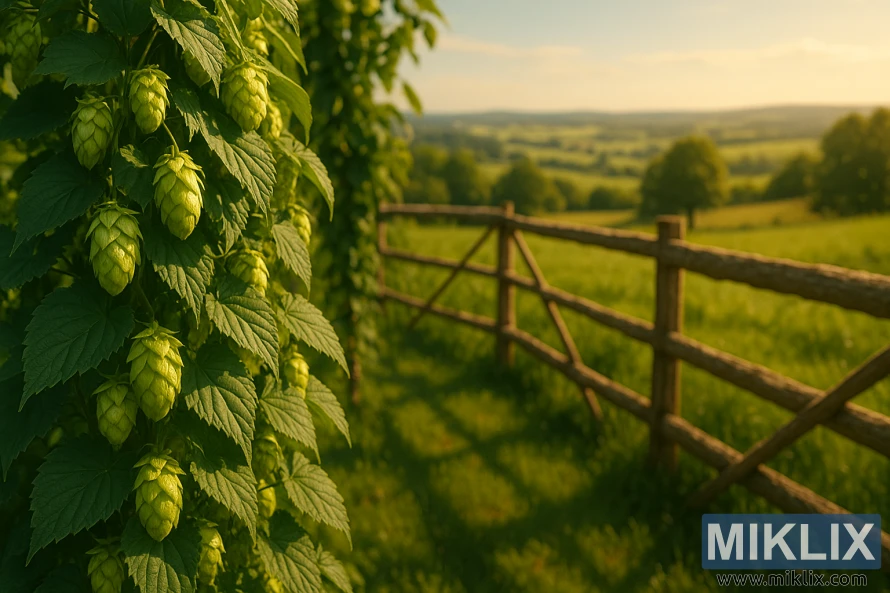
Both commercial breweries and homebrewers appreciate Northdown hops for their versatility. This guide will dive into their origins, flavor, brewing characteristics, and practical uses. It aims to help you determine if Northdown is right for your next brewing project.
Key Takeaways
- Northdown hops originated at Wye College and were released in 1970.
- The Northdown hop variety is a cross between Northern Brewer and Challenger.
- As British hops, they offer balanced earthy and floral notes suitable for ales and lagers.
- They provide reliable disease resistance and consistent performance for brewers.
- This hop guide will cover flavor, chemistry, and practical brewing tips.
Overview of Northdown hops: origin and breeding
Northdown hops originated from Wye College hops breeding in England. Introduced in 1970, it is known by the international code NOR and breeder code 1/61/55. The goal at Wye College was to enhance disease resistance and meet contemporary brewing demands.
The lineage of Northdown is Northern Brewer x Challenger. This heritage places it within the English hop family. It is also the aunt of Target, showcasing its genetic significance. This background allowed for a balance between bitterness and aroma.
Initially an English variety, Northdown's popularity has led to commercial cultivation in the United States. Growers and suppliers there offer cones and pellets, catering to brewers who seek its traditional flavor. This expansion highlights the variety's global appeal and adaptability to new environments.
The breeding objectives at Wye College emphasized consistent yields and field durability. Northdown achieved these while maintaining its appeal to brewers. Its steady alpha acids and aromatic qualities are a testament to its Northern Brewer x Challenger lineage and broader hop genealogy.
Flavor and aroma profile of Northdown hops
The aroma of Northdown hops is complex and refreshing. It is often described as having a woody character, with notes of cedar and resinous pine. This gives beers a robust, woody backbone.
Brewers appreciate the cedar pine hops for their savory, forest-like quality. These flavors complement darker malts, enhancing the beer's overall character without dominating it.
At lower usage rates, Northdown reveals its floral berry hops. These add a soft, delicate topnote to the beer. The floral aspect is subtle, while the berry notes introduce a mild fruity undertone.
The spicy hops character emerges in the midpalate. It brings a subtle pepper or clove nuance. This helps balance the sweetness, cutting through caramel or roasted grains.
In summary, Northdown hops offer a rich yet balanced flavor profile. The combination of cedar, pine, floral, and berry notes makes it ideal for adding depth to malt-driven beers.
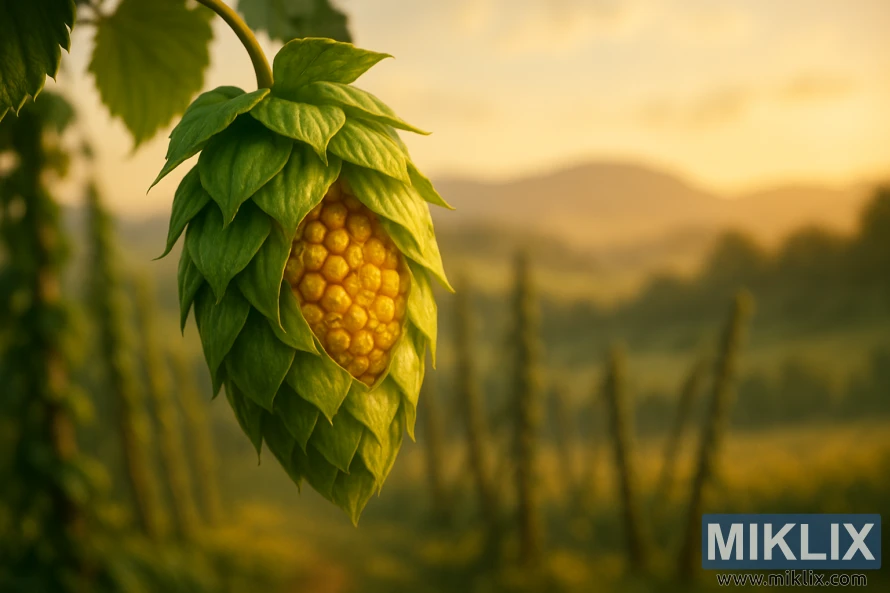
Brewing characteristics and alpha/beta acid ranges
Northdown hops offer a moderate-to-high bittering profile. Alpha acid values typically range from 6.0% to 9.6%, averaging around 8.5%. This makes it a reliable choice for early boil additions, ensuring consistent IBUs.
The beta acid content in Northdown is generally between 4.0% and 5.5%, averaging 4.8% or 5.0%. This beta presence impacts aging stability and aroma retention, as beta acids oxidize differently than alpha acids.
Co-humulone in Northdown is approximately 24–32% of the alpha fraction, averaging 28%. This moderate co-humulone percentage contributes to a clean, smooth hop bitterness when properly mashed and boiled.
The alpha-to-beta ratio for Northdown is roughly 1:1 to 3:1, averaging 2:1. This balance makes Northdown suitable for both bittering and flavor/aroma contributions, even when added late in the boil or during whirlpool.
Total oils in Northdown range from 1.2 to 2.5 mL per 100 g, averaging 1.9 mL/100 g. These oils contribute floral and lightly spicy notes, enhancing the beer's aroma when used for late additions, whirlpool hops, or dry-hopping.
- Alpha range: commonly 6–9.6%, average ~8.5% — impacts hop bitterness and IBU calculations.
- Beta range: ~4.0–5.5%, average ~4.8% — affects aroma retention and aging.
- Co-humulone: 24–32%, average ~28% — contributes to smoothness of bitterness.
- Total oils: 1.2–2.5 mL/100 g, average ~1.9 mL/100 g — supports late-hop aromatic lift.
When crafting recipes, adjust boil times and hop addition rates to achieve the desired bitterness and aroma. Early additions ensure IBUs from Northdown's alpha acid. Late additions leverage total oils for flavor enhancement without introducing harsh co-humulone-derived notes.
Dual-purpose use: bittering and aroma roles
Northdown stands out as a dual purpose hop, ideal for brewers aiming for a single variety for both boil and late-hop additions. Its moderate-to-high alpha acids ensure a clean, firm bitterness. This is perfect for early boil additions, establishing a beer's backbone.
For late additions, Northdown reveals cedar, pine, floral, and light berry notes. These survive whirlpool and dry-hop stages. Brewers often add it in the whirlpool or during fermentation. This captures subtle resinous aromatics without overpowering malt or yeast.
As a single-hop option, Northdown's bittering and oil content offer balance and clarity. It provides structured bitterness while contributing enough volatile oils for aroma. This makes it a practical choice for traditional British ales and hybrid styles.
Compared to modern American varieties like Citra or Mosaic, Northdown favors nuanced, resinous flavors over bold tropical notes. Craft brewers choose it for its restrained aromatics and dependable bittering from a single hop.
- Use early boil additions for firm, smooth Northdown bittering.
- Reserve late-boil, whirlpool, or dry-hop for Northdown aroma impact.
- Employ as a single-hop option when balanced bittering and aroma hops are needed.
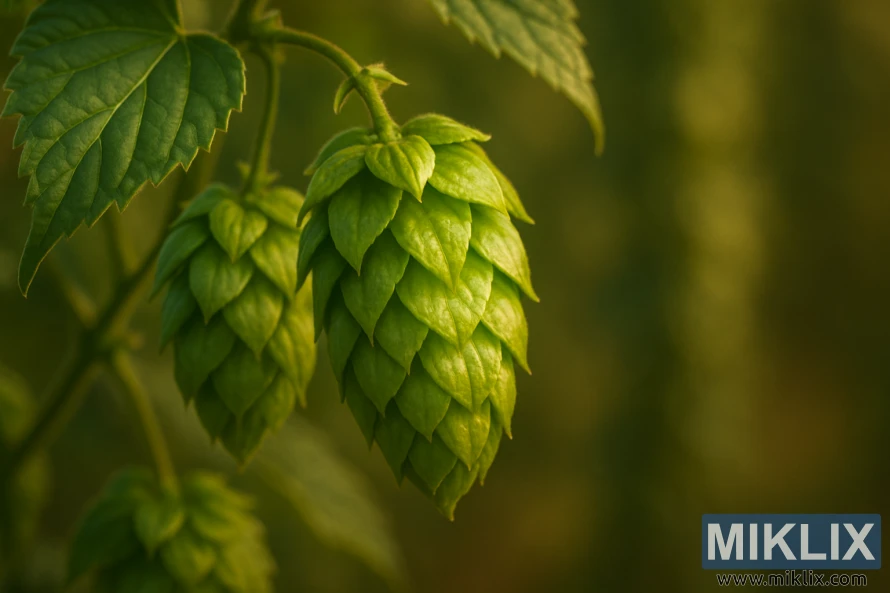
Hop oil composition and sensory effects
Northdown hop oils typically contain about 1.9 mL per 100 g, ranging from 1.2 to 2.5 mL. This oil blend significantly influences the hop sensory profile in both whirlpool and dry-hop additions.
Humulene, making up roughly 40–45% of the total oil, is the dominant component. Its presence gives Northdown a distinct woody, noble, and spicy character. Many describe it as having cedar and dry-wood notes, thanks to humulene.
Myrcene, at about 23–29%, adds resinous, citrus, and fruity notes. These bright, resinous top notes enhance the hop sensory profile, making it ideal for aromatic roles in ales.
Caryophyllene, accounting for around 13–17%, introduces peppery, woody, and herbal facets. The combination of myrcene, humulene, and caryophyllene creates a complex mix of spice, wood, and fruit.
Farnesene, present in small amounts of 0–1%, contributes fresh green and floral highlights. Other compounds like β-pinene, linalool, geraniol, and selinene make up the remaining 8–24%. They add citrus, floral, and green characters to the profile.
- Average total oil: ~1.9 mL/100 g
- Humulene: ~42.5% — woody, cedar, noble spice
- Myrcene: ~26% — resinous, citrus, fruity
- Caryophyllene: ~15% — peppery, herbal, woody
When planning hop additions, the oil balance is crucial. High humulene supports cedar and dry spice, while myrcene and caryophyllene add resin and pepper. This balance defines the Northdown hop sensory profile, guiding brewers in dosage and timing choices.
Practical brewing applications and recommended dosages
Northdown is versatile, suitable for bittering, late-boil aroma, whirlpool hop, and dry-hopping. It's often used as a dual-purpose hop. Adjust the dosage based on whether you prefer a strong bitterness or a more pronounced aroma.
For bittering at 60 minutes, calculate IBUs using Northdown’s alpha acids, typically 7–9%. It's ideal as a primary bittering hop for beers aiming for moderate to high IBUs. The exact hop addition rates depend on batch size and target bitterness.
Late additions and whirlpool hop dosing range from 0.5–2.0 oz per 5 gallons (15–60 g per 19 L). Opt for the lower end for subtle floral notes. For a clear Northdown character in pale ales and bitters, use higher rates.
Dry-hopping follows the same guidelines as late additions: 0.5–2.0 oz per 5 gallons. Northdown imparts a softer, more English-style aroma compared to many modern American hops. Increase dry hop amounts for a stronger, fruitier nose in IPAs and session ales.
- Typical bittering: treat like other high-alpha English hops; adjust for alpha percent before adding.
- Whirlpool hop: use 0.5–2.0 oz per 5 gallons for aroma extraction without excessive vegetal notes.
- Dry hop amounts: start conservative, then adjust by 25–50% in future brews if aroma is weak.
Before final dosing, account for crop variation. Check supplier analysis for harvest year, AA%, and oil content. Small shifts in alpha or oil levels require recalculating hop addition rates to achieve the desired balance.
For recipe scaling, the guideline (0.5–2.0 oz per 5 gallons) scales linearly. Commercial brewers might use higher rates, while homebrewers often stick to the mid-range to manage costs and green flavors. Keep track of outcomes and note each batch's details.
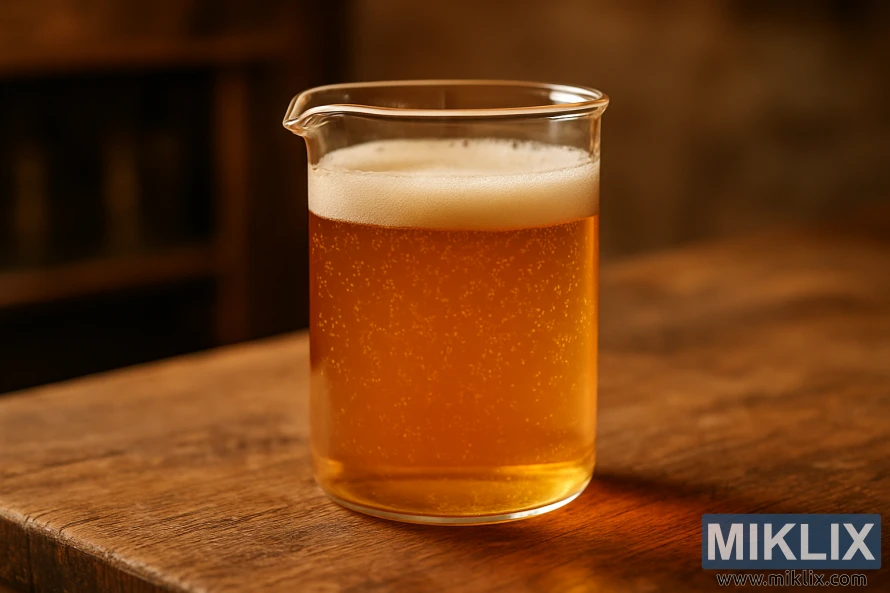
Beer styles that showcase Northdown hops
Northdown excels in malt-forward beers, enhancing cedar, pine, and spice notes. It's a favorite for Heavy Ales and traditional English ales. Its resinous character complements rich malt without overpowering the taste.
In porters and stouts, Northdown adds a woody, resinous layer. This complements roasted barley and chocolate malts. Use it in moderation to preserve roast clarity while adding depth to the midpalate.
Northdown is versatile in ales, suitable for both session and full-strength beers. In English-style bitters or old ales, it enhances biscuit and toffee malts. It adds a subtle piney backbone that matures well over time.
- Heavy Ale: bittering strength and aging support from barleywine hops traits.
- Barley Wine: barleywine hops provide a firm bittering frame for very high gravities and long cellaring.
- Porter and Stout: adds woody resin without masking roast.
- Bock and Traditional English Ale: balances sweet malt with spice and cedar notes.
When brewing with Northdown, consider late-kettle additions for lively aroma. Early additions provide a stable bittering base. This hop benefits from restraint, pairing best with malts that hold flavor through warm aging and oxidation.
Northdown hops in commercial versus homebrewing
Breweries opt for Northdown for its consistency in commercial brewing. Growers note steady hop yields and robust plants that fend off diseases. This stability aids in achieving precise alpha ranges and managing costs in large-scale brewing.
Commercial breweries value the predictable oil content and uniform hop yields. These traits reduce waste and simplify inventory management. Brewers at Sierra Nevada and Samuel Adams, for instance, rely on Northdown for its reliable performance in scaling recipes.
Homebrewers, on the other hand, choose Northdown for its traditional English character and ease of use. They appreciate its versatility in brewing bitters, pale ales, and brown ales. Many homebrew recipes include Northdown, as it complements Maris Otter and crystal malts well.
Availability varies between commercial and homebrew markets. Commercial buyers secure large contracts and specific harvest lots for uniformity. Homebrewers, by contrast, purchase smaller packs from local shops or online, where prices and crop years can fluctuate. This can lead to subtle flavor variations unless the brewer adjusts hopping rates.
- Commercial focus: batch consistency, bulk purchasing, and cost control.
- Homebrew focus: flavor flexibility, ease of use, and recipe tradition.
- Shared benefit: both groups benefit from predictable hop yields and manageable alpha ranges.
When choosing between pellet or whole-cone forms, commercial brewers often prefer processed options for their efficiency. Homebrewers, on the other hand, select based on their workflow and budget. Understanding Northdown's behavior is crucial for both professionals and hobbyists to achieve consistent results.
Substitutes and hop pairing strategies
Northdown substitutes often include British and European bittering hops with resinous, cedar-like notes. Target, Challenger, Admiral, and Northern Brewer are common choices. Northern Brewer is often preferred for its woody bitterness and drying finish.
When substituting Northdown, focus on alpha acid and oil profile. Target and Challenger offer similar bittering power and a piney backbone. Adjust late additions to restore aroma balance if using a higher-alpha hop.
Hop pairings are most effective when layered. For a classic English character, blend Northdown-style hops with East Kent Goldings or Fuggle. This combination adds earthy, floral, and mild spice notes that complement the resinous base.
To enhance resin and wood tones, pair Northdown or a Northern Brewer substitute with Challenger or Target. This reinforces the piney, cedar-like structure, ideal for bitters, brown ales, and ESBs.
Modern fruit-forward hops require careful use. Blend Citra or Mosaic sparingly with Northdown to preserve the traditional resinous profile. Use Northdown as the structural hop and add modern aromatics in small late additions or dry hop.
- Use pellets or whole cones; no cryo or lupulin-dense options are commercially available for this variety.
- For bittering, match alpha acids then tweak late additions for aroma.
- In dry hopping, favor low rates of modern varieties to avoid masking classic notes.
Availability, purchasing, and forms (cones vs pellets)
Many hop suppliers in the United States and Europe offer Northdown hops. You can find them at specialty hop suppliers, general brewing shops, and online marketplaces. Availability depends on the current crop season.
Suppliers provide both Northdown cones and pellets. Cones are preferred for their whole-leaf handling, while pellets are chosen for their convenience in storage and dosing. Before making a purchase, check the product pages for harvest year and lab analysis. This helps avoid surprises due to crop variations.
Bulk orders are ideal for commercial breweries needing consistent supplies. Homebrewers often opt for small packs to test flavor and alpha-acid differences. When comparing offers, pay attention to AA%, beta%, and oil content. Suppliers like Yakima Chief Hops and BarthHaas provide detailed information.
- Buy Northdown hops: confirm harvest year and test reports.
- Northdown cones: best for gentle handling and aroma preservation.
- Northdown pellets: easier to store and measure for repeatable recipes.
- Hop suppliers: compare prices, shipping, and cold-chain options.
Leading producers do not offer major lupulin concentrates like Cryo or Lupomax for Northdown. If you need these products, contact hop suppliers directly. They might have experimental runs or small-batch offerings.
When ordering internationally, use the NOR code to ensure correct variety handling. Always review the supplier's return policy and lab certificates if you plan to buy Northdown hops in larger quantities for production.
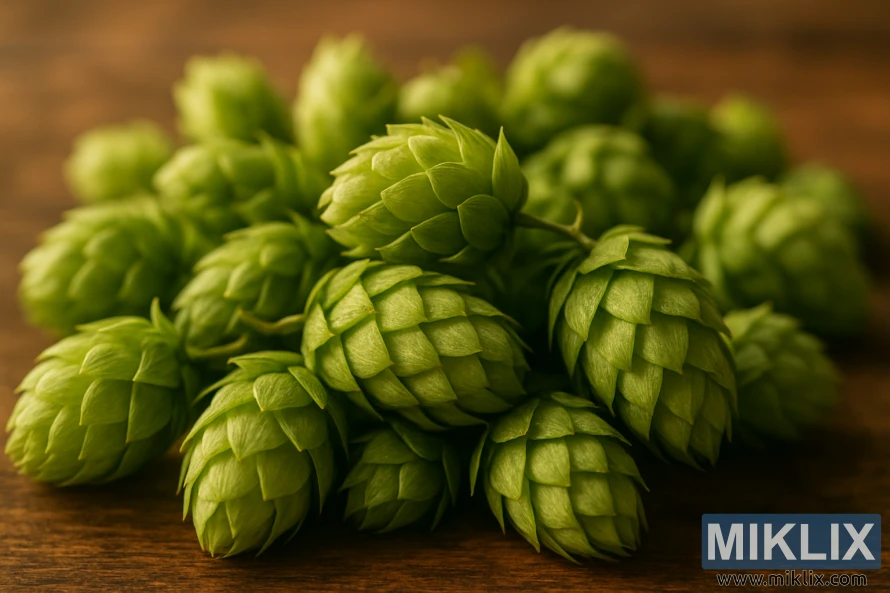
Recipe ideas and example formulations using Northdown
Below are practical, conceptual guidelines for brewers who want to showcase Northdown. These notes cover hop timing, malt choices, and dosage ranges for different beer styles.
English Bitter / Pale Ale (Northdown-forward)
Use Northdown as the primary hop. Add a bittering charge at 60 minutes to hit the target IBUs, then a 10-minute addition to lift aromatics. Finish with a short hopstand or whirlpool at 170–180°F to emphasize floral and cedar notes. This approach works for single-hop showcases and for Northdown recipes that highlight traditional English character.
Northdown IPA
Start with Northdown for early bittering, accounting for its alpha acids when calculating IBUs. Emphasize late kettle and dry-hop additions to bring out resin and pine. Use a clean pale malt base and a touch of crystal malt for balance. For late additions and dry hopping, a guideline of 0.5–2.0 oz per 5 gallons helps dial aroma without overpowering bitterness.
Robust Porter / Northdown porter recipe
Let Northdown carry the bittering load while adding small late additions for cedar and pine complexity. Pair it with chocolate and roasted malts to keep the profile dark and balanced. Keep late hops modest so the roasted malt stays primary, yet the hop spice cuts through on the finish.
Northdown barleywine
For a barleywine or heavy ale, use Northdown early for a firm bitter backbone, then add large whirlpool and dry-hop doses to build resinous, age-worthy complexity. High gravity requires measured bittering and generous late additions to keep the aroma lively as the beer matures.
Dosage guidance: for flavor and aroma work, aim for 0.5–2.0 oz per 5 gallons on late additions or dry hop. For bittering, adjust hops to alpha acid percentage and desired IBUs. If Northdown is unavailable, Northern Brewer or Challenger make practical substitutes, though aroma shifts toward sharper mint and spice should be expected.
These formulations help brewers adapt recipes to their systems. Tweak late-hop amounts and steep times to suit water chemistry, yeast strain, and desired bitterness. Use measured trials to refine Northdown recipes for repeatable, balanced results.
Common questions brewers have about Northdown (myths and facts)
Brewers often ponder if Northdown is outdated compared to modern American aroma hops. Many believe it's no longer relevant, a common myth. Yet, Northdown remains suitable for traditional British and some hybrid styles. It offers cedar, pine, and subtle spice, qualities missing in many modern hops.
Another concern is whether Northdown adds aroma when used late or as a dry-hop. This doubt is also a myth. Northdown facts reveal it has total oils around 1.2–2.5 mL/100g. This means late additions and dry-hop doses do contribute noticeable scent, though less intense than many U.S. hops.
Homebrewers often wonder, are Northdown hops spicy? The answer is yes, but in a balanced way. The spice is part of its allure, not overwhelming. Use it sparingly to allow cedar and resinous pine to balance the spice.
- Is Northdown good for bittering? Northdown bitterness is reliable. Alpha acids commonly sit near 7–9%, yielding firm, smooth bitterness when used early in the boil.
- Are lupulin or Cryo forms available? Current listings from major suppliers show no widespread Cryo or lupulin products for Northdown, so pellets and whole cones remain the main options.
- What are accepted substitutes? Northern Brewer, Target, Challenger, and Admiral serve as practical swaps depending on whether you need aroma or clean bitterness.
These points clarify the truth behind Northdown myths and provide brewers with practical advice for recipe development. Use Northdown where its cedar-pine-spice profile will shine. Treat it as a dual-purpose hop that can deliver both aroma and dependable bitterness.
Conclusion
Northdown hop summary: Northdown is a robust, versatile British hop variety. It is known for its consistent yields and balanced bittering profile. With high single-digit alpha acids and oils rich in humulene, myrcene, and caryophyllene, it imparts cedar, pine, and spicy-floral notes. These characteristics make it suitable for both bittering and late additions in brewing.
Brewers aiming for Northdown brewing uses will find it effective in traditional English ales, porters, stouts, barley wines, and bocks. It's best used for base bittering at measured dosages. Reserve late additions for subtle aroma and spice. If you're looking for alternatives, Northern Brewer, Challenger, and Target are good options that serve a similar functional role.
When selecting Northdown hops, consider the harvest year and whether you prefer cones or pellets. There are no lupulin or cryo forms widely available, so plan your recipes and adjustments based on the alpha/beta ranges. Overall, Northdown is a practical choice for brewers seeking steady performance and classic British character.
Further Reading
If you enjoyed this post, you may also like these suggestions:
